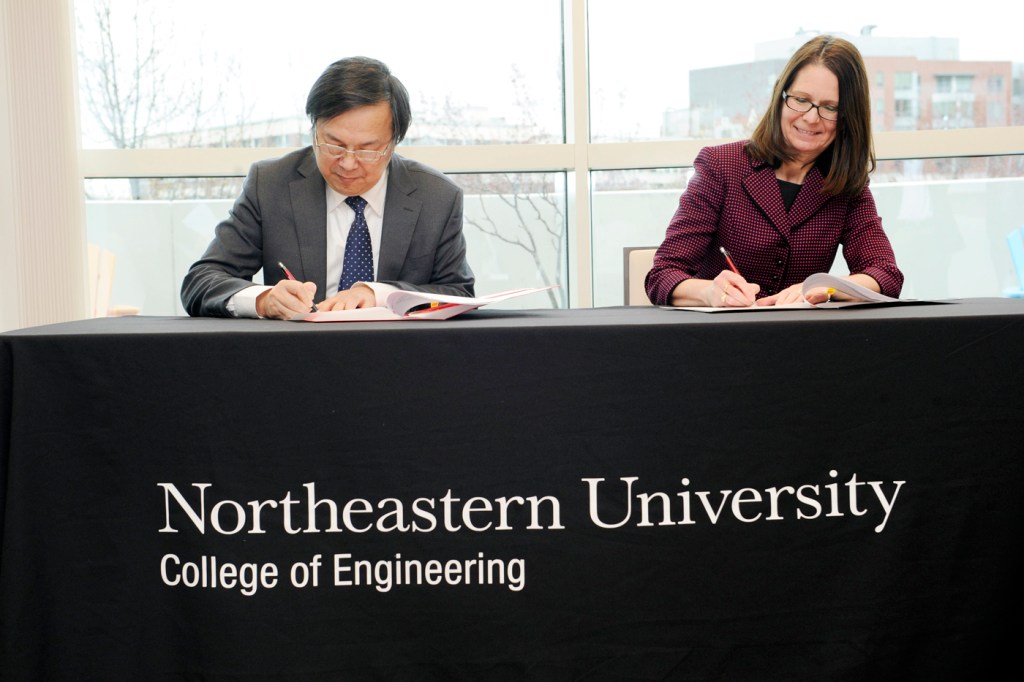Picotechnology in the center of new research partnership

Northeastern University and Wenzhou Medical University in China have partnered to combine their expertise in nanotechnology and medicine, respectively, to collaborate on research focusing on reducing eye infections caused by contact lenses and intraocular devices.
Through this partnership, the researchers will explore the emerging field of picotechnology, which involves the manipulation of matter on an even smaller scale than is used in nanotechnology.
“Nanomedicine is particularly an area of focus for our research at the College of Engineering, and picomedicine is taking the field to the next frontier,” said Nadine Aubry, dean of Northeastern’s College of Engineering.
Aubry and Wenzhou Medical University President Qu Jia formally established the partnership at a ceremony at Northeastern on Monday, when they signed a memorandum of understanding. Thomas Webster, the Art Zafiropoulo Chair and professor and chair of the Department of Chemical Engineering, will lead Northeastern’s research team as part of this initiative.
“This is just the start of something great,” said Webster, who visited Wenzhou Medical University earlier this year.

Thomas Webster, the Art Zafiropoulo Chair of the Department of Chemical Engineering, speaks to guests at a ceremony held for the new research partnership between Northeastern and Wenzhou Medical University in China. He will lead Northeastern’s research team as part of the partnership. Photo by Matthew Modoono/Northeastern University
Nanomaterials lead the way
Webster is an internationally renowned researcher who has pioneered the use of nanotechnology to improve medical devices. He is the founder and editor- in- chief of the International Journal of Nanomedicine, and he is president of the U.S. Society for Biomaterials. His lab’s work to date includes creating injectable nanomaterials that promote the growth and regeneration of bones and cartilage, and developing nanomaterials that fight viruses and infections. He has also launched eight companies, holds numerous patents, and is one of the most- cited researchers in the area of materials science.
Eye infections are a costly problem
Northeastern will collaborate with Wenzhou Medical University and its Institute of Biomaterials and Engineering. To kick off the collaboration Webster has identified a series of research projects that focus on reducing eye infections caused by contact lenses and intraocular devices used to test for glaucoma. One project would involve Webster’s team developing nanosensors that could detect and respond to eye infections, and the projects collectively would leverage the Chinese researchers’ expertise in ophthalmology.
According to the Centers for Disease Control and Prevention, keratitis—a painful eye infection often linked to improper contact lens use—leads to 1 million doctor and hospital visits annually, at a cost of $175 million to the U.S. healthcare system.
“There is great potential for us to collaborate,” Qu said, via a translator, adding that combining their institutions’ expertise in nanotechnology and medicine will produce great patient outcomes.
Picotechnology vs. nanotechnology
The partnership, Webster said, could also position the university at the forefront of the emerging field of picotechnology. The diameter of one strand of human hair, Webster said, is about 80,000 nanometers. Picotechnology, he explained, involves research on an even smaller scale.
The two fields can also be leveraged in different ways, he noted. Nanomaterials are built atom by atom, while picoscience focuses on the electrons circulating within the atom, and changing how these electrons are distributed can produce interesting properties, he said.
Webster described one potential medical application of picotechnology, as it relates to this partnership. One problem with intraocular devices, he said, is that bacteria stick to them. But exciting the electrons with infrared wavelengths could cause the bacteria to instead be repelled away.
“Picotechnology can get pretty technical,” he said, “but it’s all about the electrons.”
Research that solves real problems, experience that teaches
Aubry added that the partnership also highlights the College of Engineering’s emphasis on bioengineering and its new department in this area. It also aligns with Northeastern’s focus on use-inspired research to solve global challenges in health, which is one of the university’s three programmatic research pillars.
In addition to research, Webster noted that the collaboration would include opportunities for student exchanges between the two universities, co-op experiences for Northeastern students, and Northeastern-led workshops to help educate their Chinese collaborators on the United States’ regulatory policies.





